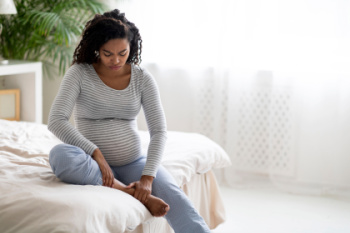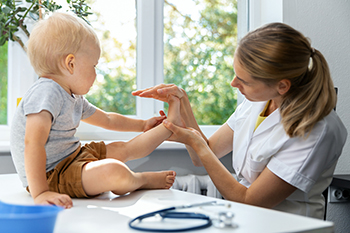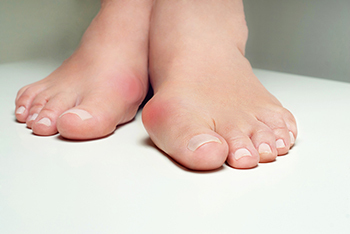

Pregnancy brings about a multitude of changes in a woman's body, including the feet. As the body undergoes hormonal shifts and weight gain, it is not uncommon for expectant mothers to experience foot pain and discomfort. One common area of foot pain during pregnancy is the arches, as the added weight can cause the arches to flatten, leading to strain and discomfort. Additionally, swelling of the feet and ankles, known as edema, is a prevalent issue, particularly in the later stages of pregnancy. This swelling can cause tightness and discomfort in various areas of the feet. Another common source of foot pain during pregnancy is the heels, as the increased weight and changes in posture can place extra pressure on the heel area, resulting in pain and tenderness. If you have foot pain during your pregnancy, it is suggested that you consult a podiatrist who can offer you relief tips during this transformative time.
Pregnant women with swollen feet can be treated with a variety of different methods that are readily available. For more information about other cures for swollen feet during pregnancy, consult with Massimo Pietrantoni, DPM from Rochester Podiatry, LLP. Our doctor will attend to all of your foot and ankle needs.
What Foot Problems Can Arise During Pregnancy?
One problem that can occur is overpronation, which occurs when the arch of the foot flattens and tends to roll inward. This can cause pain and discomfort in your heels while you’re walking or even just standing up, trying to support your baby.
Another problem is edema, or swelling in the extremities. This often affects the feet during pregnancy but tends to occur in the later stages.
How Can I Keep My Feet Healthy During Pregnancy?
If you have any questions please feel free to contact one of our offices located in Brighton and Greece of Rochester, NY . We offer the newest diagnostic and treatment technologies for all your foot and ankle needs.

Feet are fascinating parts of the body with many interesting facts that children can learn about. Humans have 26 bones in each foot, and these bones work together to provide support, balance, and mobility. The feet have over 100 muscles, tendons, and ligaments, allowing for intricate movements like walking, running, and jumping. Feet also contain thousands of sweat glands, helping to regulate body temperature and keep them cool. Additionally, the soles of the feet are covered in tough skin called calluses, which protect them from friction and pressure. Kids might be surprised to learn that the size and shape of their feet can change as they grow, which is why it is essential to wear properly fitting shoes. By understanding these fun foot facts, children can appreciate the incredible design and functionality of their feet while learning how to care for them to stay healthy and active. If your child has foot pain for any reason, it is suggested that you visit a podiatrist who can offer appropriate treatment options.
The health of a child’s feet is vital to their overall well-being. If you have any questions regarding foot health, contact Massimo Pietrantoni, DPM of Rochester Podiatry, LLP. Our doctor can provide the care you need to keep you pain-free and on your feet.
Tips for Keeping Children's Feet Healthy
If you have any questions, please feel free to contact one of our offices located in Brighton and Greece of Rochester, NY . We offer the newest diagnostic and treatment technologies for all your foot care needs.

Bunions, a prevalent foot condition, present distinctive signs that warrant attention for timely intervention. Characterized by a bony bump at the base of the big toe, bunions often cause pain, swelling, and redness in the affected area. As the condition progresses, the big toe may gradually deviate toward the other toes, causing discomfort and difficulty finding comfortable footwear. Additionally, individuals with bunions may experience corns or calluses due to friction and pressure against the shoe. Bunions can impair mobility and lead to chronic foot problems if left untreated. Factors such as genetics, wearing ill-fitting shoes, and certain foot deformities contribute to the development of bunions. Moreover, conditions like arthritis may exacerbate bunion symptoms. Understanding the signs of a bunion is essential for maintaining foot health and enhancing overall quality of life. If you have developed a bunion, it is suggested that you consult a podiatrist who can offer you effective treatment options, which may include surgery for permanent removal.
If you are suffering from bunion pain, contact Massimo Pietrantoni, DPM of Rochester Podiatry, LLP. Our doctor can provide the care you need to keep you pain-free and on your feet.
What Is a Bunion?
Bunions are painful bony bumps that usually develop on the inside of the foot at the joint of the big toe. As the deformity increases over time, it may become painful to walk and wear shoes. Women are more likely to exacerbate existing bunions since they often wear tight, narrow shoes that shift their toes together. Bunion pain can be relieved by wearing wider shoes with enough room for the toes.
Causes
Symptoms
In order to diagnose your bunion, your podiatrist may ask about your medical history, symptoms, and general health. Your doctor might also order an x-ray to take a closer look at your feet. Nonsurgical treatment options include orthotics, padding, icing, changes in footwear, and medication. If nonsurgical treatments don’t alleviate your bunion pain, surgery may be necessary.
If you have any questions, please feel free to contact one of our offices located in Brighton and Greece of Rochester, NY . We offer the newest diagnostic and treatment technologies for all your foot care needs.